forex charts
forex charts |
- Gold & Silver Price Charts – Test of Trend Support Nearing - DailyFX
- S&P 500, Dow, and Nasdaq 100 Charts: On to the Next Big Levels of Resistance - DailyFX
- The famous classical technical chart patterns - ForexLive
| Gold & Silver Price Charts – Test of Trend Support Nearing - DailyFX Posted: 27 Feb 2019 02:12 AM PST Gold/Silver Technical Highlights:
See what drivers DailyFX analysts expect to move Gold in the coming weeks in the Q1 Gold Forecast. Test of November trend-line in gold approachingThe reversal in gold last week has quickly come to a grinding halt, with the past few days sporting very little activity. That looks set to change perhaps as soon as today, and on that may come a testing of the important November trend-line/lower parallel. After getting rejected from around long-term resistance, holding the Nov trend-line will be important as a break could lead to a pick up in selling. The trend-line has numerous inflection points also adding weight to its importance. One of these times it may not hold, but until it doesn't it is viewed as support. A move higher doesn't leave a lot of room for a good long trade with resistance not far ahead. One scenario that may offer up some 'juice', is for a bounce off the trend-line then lower-high and break of the trend-line, furthering along last week's key reversal. For now, though, in 'wait-and-see' mode. Check out the IG Client Sentiment page to see how changes in trader positioning can help signal the next price move in gold and other major markets. Gold Daily Chart (Watch the Nov t-line)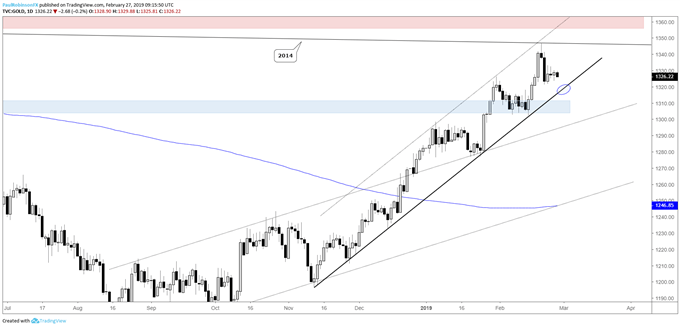 Gold Weekly Chart (Reversal around big long-term resistance)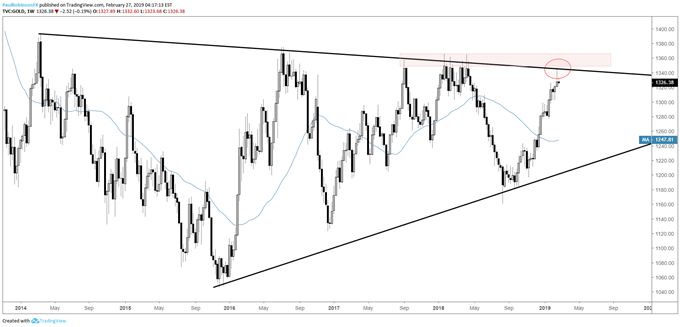 Silver has a couple of degrees of support it may soon testSilver's outlook is even worse on the upside, due to it not only lagging gold but also have a good deal of resistance by way of several trend-lines: 2003, July 2016, and April 2017 t-lines all run in the same vicinity. Keeping it supported trend-lines from December and last month, but both aren't off the highest quality given the number of touch points. A break of these, though, will further validate resistance, and if gold fails to hold the November trend-line – selling could pick up quickly for this long-time laggard. Silver Daily Chart (Lots of resistance)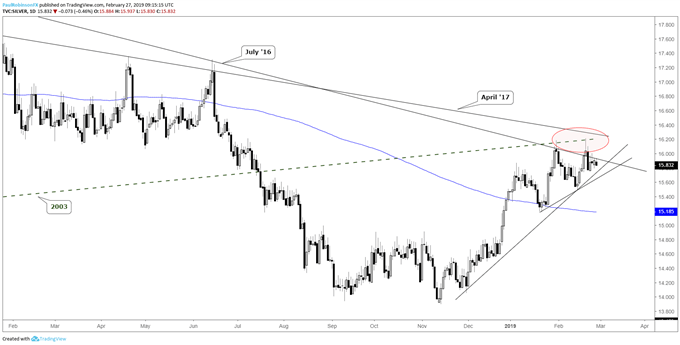 Resources for Forex & CFD TradersWhether you are a new or experienced trader, we have several resources available to help you; indicator for tracking trader sentiment, quarterly trading forecasts, analytical and educational webinars held daily, trading guides to help you improve trading performance, and one specifically for those who are new to forex. ---Written by Paul Robinson, Market Analyst You can follow Paul on Twitter at @PaulRobinsonFX |
| S&P 500, Dow, and Nasdaq 100 Charts: On to the Next Big Levels of Resistance - DailyFX Posted: 19 Feb 2019 12:00 AM PST S&P 500/Dow Jones/Nasdaq 100 Technical Highlights:
Check out the forecasts for Global Stock Indices and other markets on the Trading Guides page. S&P 500 nearing 2800-area, several swing-highs from last yearThe S&P 500 is continuing to show impressive strength since its v-bottom began the day after Christmas, with it having a few points along the way where it could have been stopped in its tracks. But it wasn't, and this has levels prior to the December swoon in view. The area surrounding 2800 is a big one. From 2800 up to 2817 there were three peaks created from failed rallies, a logical area, with the rally having come this far, to look for stocks to weaken from. Watching price action will be key, as always, but especially around the levels just ahead. While resistance looks likely to get tested soon, the upward channel structure over the past month will keep stocks pointed higher for as long as it holds. If the S&P is rejected off resistance, to further bolster the notion of a sizable retracement we'll need to see the underside parallel undermined. For now, the top-side must be respected, but the time for material weakness may be nearing… Stocks are rallying, but will it last in the long-term? Find out where our analysts see stocks headed in the Global Equities Forecast. S&P 500 Daily Chart (2800/817 big spot)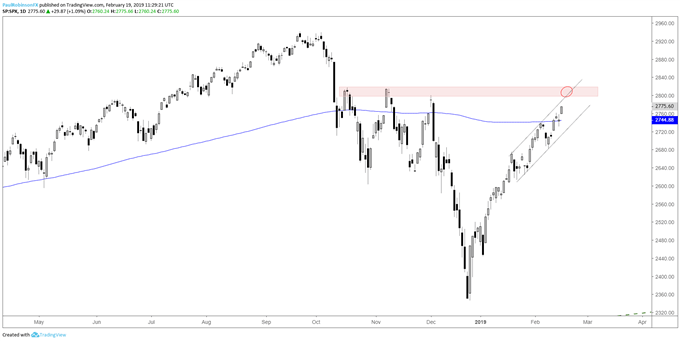 Dow Jones 26k-ish stands between it and record highsThe Dow is nearing the 26k-area, a spot which is basically the equivalent of what 2800 is to the S&P 500. The zone runs up to near 26300. The focus is primarily on the S&P right now as it is the broader index, but depending on how price action plays out, the Dow may be the better index to short at some point if it shows relative weakness to the broader market. Dow Daily Chart (26k-ish stands in the way)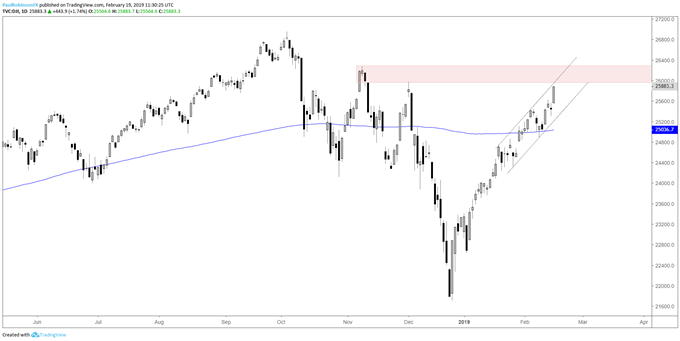 Nasdaq 100 trading around resistance alreadyThe Nasdaq 100 continues to lag behind, which is something to continue monitor given it was the bull-market leader with its leading group of stocks – FAANG – dominating price action and sentiment. The NDX is trading around the 200-day and near late-year swing highs equivalent to the ones discussed with regard to the S&P 500 and Dow. So far, relative weakness is making the 100 the preferred fade if the S&P finds material selling off resistance surrounding 2800/17. Nasdaq 100 Daily Chart (trading around resistance)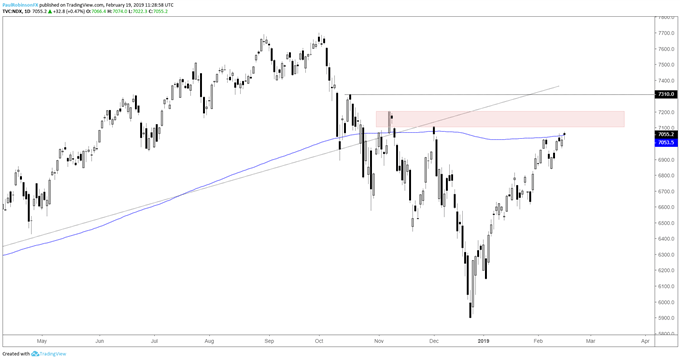 To learn more about U.S. indices, check out "The Difference between Dow, Nasdaq, and S&P 500: Major Facts & Opportunities." You can join me every Wednesday at 10 GMT for live analysis on equity indices and commodities, and for the remaining roster of live events, check out the webinar calendar. Tools for Forex & CFD TradersWhether you are a beginning or experienced trader, DailyFX has several resources available to help you; indicator for tracking trader sentiment, quarterly trading forecasts, analytical and educational webinars held daily, trading guides to help you improve trading performance, and one specifically for those who are new to forex. ---Written by Paul Robinson, Market Analyst You can follow Paul on Twitter at @PaulRobinsonFX |
| The famous classical technical chart patterns - ForexLive Posted: 25 Feb 2019 04:49 AM PST A look into the more familiar patterns on the chart This article was submitted by ICM.com. This article was submitted by ICM.com.Technical analysis is a type of analysis which is applied by traders on different financial assets, where they study the past price performance of a certain financial asset to forecast the future price direction or trend of this asset. There are numerous ways of analyzing the markets via technical analysis. Some traders might use technical indicators and oscillators, while others prefer to use the price action itself. According to the Dow Theory, the market discounts everything. In other words, the price of a certain financial asset discount all the past, current, and even future economic releases, events, etc. So by studying the price action of a certain financial product, traders will be searching for repeated price patterns which could assist them in determining the future direction of the market. In this article, we will cover the classical chart patterns which are to split into two categories: trend continuation patterns and trend reversal patterns.Continuation PatternsThey are considered as a pause in the prevailing trend which implies that during an uptrend, the bulls are preparing for another push higher whereas during a downtrend, the bears are preparing for another push lower. These patterns should be drawn properly by traders and they should be very patient while trading the breakout of such patterns to avoid being trapped in false breakouts. Usually, when these patterns take more time to form, they will be followed by significant price movements. Triangles fall under the category of continuation patterns and are of three types: symmetrical, ascending, and descending. A symmetrical triangle is formed of higher lows and lower highs which usually signals that the market is balanced and ready to move either way. As the triangle is being formed, the volume shrinks, and the breakout would be accompanied with great volume which leads the market to the next move.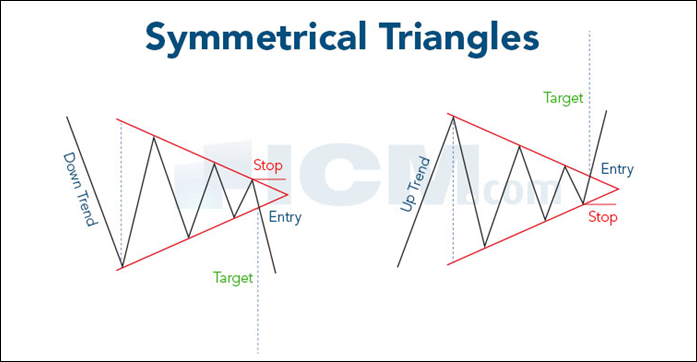 An ascending triangle is usually considered as a bullish pattern which forms in an existing uptrend. It consists of a horizontal line combining the highs or resistance points, and a line combining a series of higher lows. Despite the fact that the breakout could occur to either direction, traders usually await a break to the upside as the triangle is a continuation pattern which means that the market had a slight consolidation to prepare for an upcoming price move within the same direction of the prevailing trend.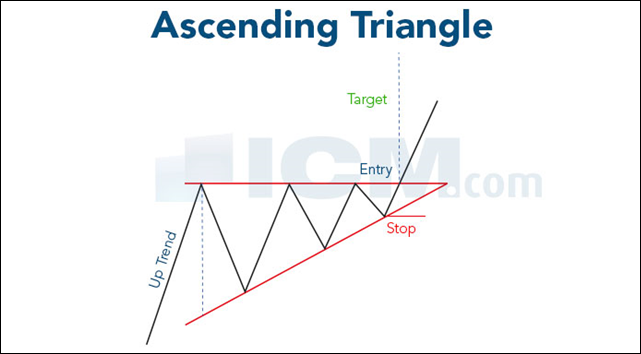 A descending triangle is considered as a bearish structure which forms in an existing downtrend. It consists of a horizontal line combining the lows or support level and a line combining a series of lower highs. Traders will be waiting for a break to the downside as they believe that the market took a pause from the prevailing trend and the trend will resume when we breakout from this consolidation pattern. 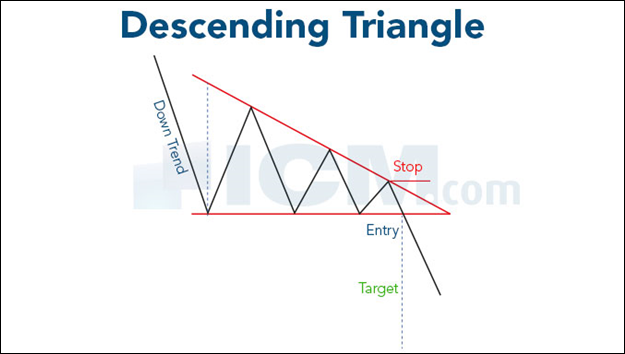 Reversal PatternsReversal patterns are patterns that occur at the end of a prevailing trend to give a signal to the trader that there could be a possibility of a change in direction. In other words, these patterns will help us indicate that the current price movement has topped or bottomed. If a trader was holding buy positions in an uptrend, and he detected the formation of a possible reversal pattern, then he should be thinking of liquidating his position and re-assess his bias. Among the most recognized classical reversal patterns are the head and shoulders formations, the double top & bottom, and the triple top & bottom. Head and Shoulders patterns consist of three peaks with the middle peak being the highest, the left and right peaks holding similar or close price levels. The volume will be the largest in the first shoulder and starts to decrease until we break out from this formation. A Head and Shoulders pattern will appear at the top of an uptrend, while an inverted head and shoulders pattern will form at the bottom of a downtrend.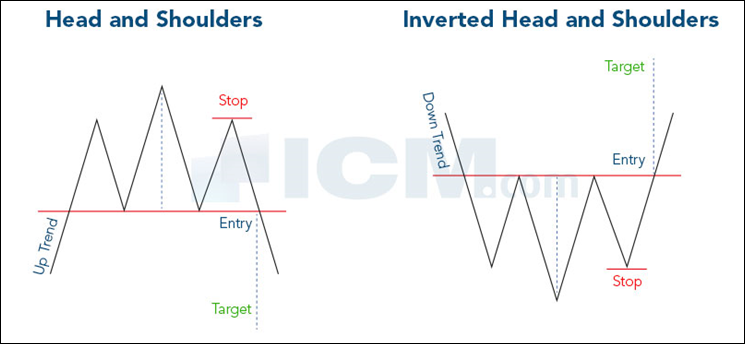 Double/Triple tops and bottoms are among the most reliable reversal chart patterns and can be found easily on charts. Usually, they are formed when the price of a financial asset retests a resistance or support zone without being able to break above or below respectively. Some traders add technical oscillators such as the Relative Strength Index and search for divergence to confirm their trading setup.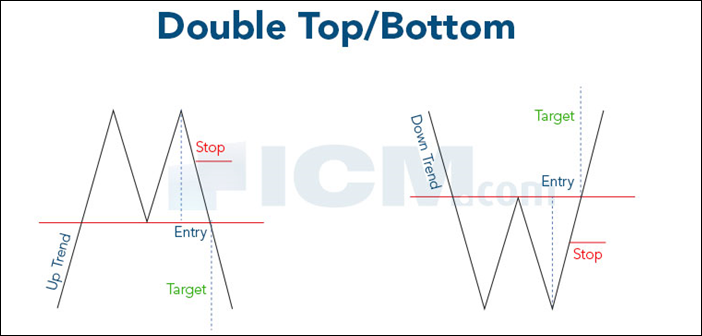 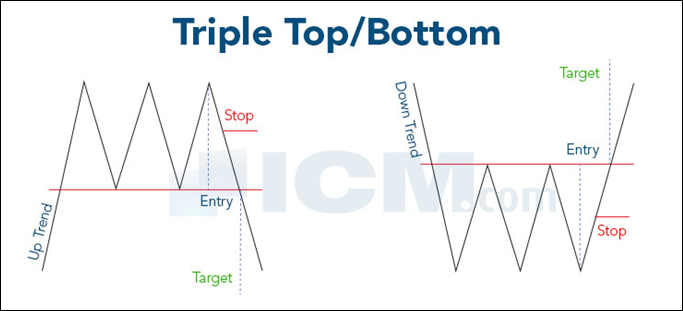 If we go over charts of different time frames or even range charts, we will be able to find a classical chart pattern, whether from the mentioned above or the rest. However, it is always better to adopt the formations that occur on higher time frames taking into consideration the length, uniformity, and clarity. Traders should always be cautious about being stuck in a false breakout. In order to avoid such entries, a trader should make sure that the breakout is occurring with heavy volume, or ignore the initial breakout and wait for a retest to the neckline/support/resistance and jump into a trade. Chart patterns will help you pick your trades. Many traders wait for such formations to trade which would lower their number of trades and also reduce the percentage of losing trades. Despite the theory that price discounts everything, it is better to always apply fundamental analysis along with technical analysis. When a technical trading setup matches the fundamental analysis findings, the trade would have a higher chance of success. Finally, we advise all traders to stick to strict risk management techniques as risk management is the key to successful trading. |
| You are subscribed to email updates from "forex charts" - Google News. To stop receiving these emails, you may unsubscribe now. | Email delivery powered by Google |
| Google, 1600 Amphitheatre Parkway, Mountain View, CA 94043, United States | |
Comments
Post a Comment